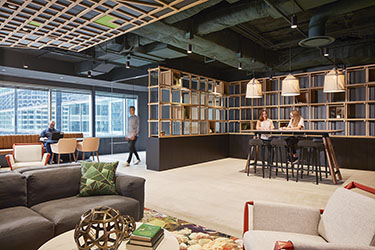|
Subscribe / Renew |
|
|
Contact Us |
|
| ► Subscribe to our Free Weekly Newsletter | |
| home | Welcome, sign in or click here to subscribe. | login |
Architecture & Engineering
| |
 |
October 3, 2019
How successful workplaces offer more than just a place to work
Gensler

Fariss
|
Growing up in northern California, my family would go camping every summer on the Mendocino Coast. It was a beautiful place. Those summers were formative, and to this day I love being near salt water; the green and gray of the coast is a palette that resonates deeply. This is perhaps why I live in the Northwest.
Places have an amazing capacity for shaping us, don’t they? Not just the formative places of our youth that we reflect on with romantic nostalgia, but the everyday places of our lives — our favorite coffee shop, the park where our kid took their first steps and even our workplaces.
As the novelist Elizabeth Bowen said, “Nothing can happen nowhere. The locale of the happening always colors the happening, and often, to a degree, shapes it.”
Place is important
But it’s also just that — a stage. And stages requires actors, because we’re ultimately talking about the experiences that we, as people, have. It’s the stories that play out in place that shape us. Apart from my experience of the Mendocino Coast, I wouldn’t know its beauty and power. Place is the platform on which people operate. It’s the hardware to our software. The relationship between people and place is an important one, and for business it is critical.
Being in the business of places, I think about this a lot. Many of our clients are as well, and I’ve seen some themes emerge among those who are creating the most value for their employees, shareholders, industries, and in some cases, society. They’ve defined the relationship between place and people in terms of possibility.
These companies understand that value creation is an ecological equation. They’ve moved beyond two-dimensional value chains and are proactively designing three-dimensional value networks.
Envision a tricycle — possibility is the front wheel, bringing momentum and direction to the enterprise. But the center of gravity exists in the back. It’s the wheels of people and place that bring structure, balance and sustainable momentum, even in the face of adversity.
I’ll call these companies “tricycle companies.” Silly metaphor, I know, but it works for our purposes here. Let’s break this down a bit.
The first question for a tricycle company is, “What is possible?” This is a question of vision and purpose. The question of possibility is one that is discontented with the status quo. This question cuts through the tyranny of the urgent and creates space to imagine what could be.
Great leaders create this space for themselves, and for others. And in doing so, they cultivate a common vision for the future which intrinsically motivates cohesive action.
This is what I mean by the momentum and direction of the front wheel. Tricycle companies have a very clear vision of the future they are working toward.
The second question of a successful company is, “What are the human conditions necessary to achieve our vision?”
This is a question of culture and emotional experience. Many of our clients come to us for workplace design services because they are navigating a significant transformation of one kind or another. Whether seeking relevance with a shifting talent demographic, questioning their identity after a merger, or trying to keep up with exponential market growth, they often believe that a new place will do the trick.
But tricycle companies know that place and people are tied to the same axle. Companies that address transformation, growth and change through designing places serve the evolving needs of their people. They also understand that place can’t solve all the needs of people. Workplaces are primarily thought of as platforms for efficiency and productivity.
Putting people first
However, in this age of innovation and creativity, it is imperative that workplaces support not only good thinking but good feeling. Our own research, and the research of others, has shown that people must feel deep emotional security to strive past “tasks” and actively think and do within the expanses of their creative potential. Sure, place can provide a sense of security, but ultimately this will be found in the trust and respect people have for each other.
Being human is hard and messy. Companies that embrace this actively cultivate relational conditions that allow for judgment-free vulnerability. They don’t tolerate shaming and have worked hard to become inclusive communities of people.
When what’s possible is given significant consideration, when clear direction and momentum exists, when the soft systems of culture and people are prioritized, place becomes especially powerful. Companies that understand the purpose of place are grounded in a future of possibility and people. When these companies design workplaces, it’s not just more of the same. These places become formative, memorable, and grounding. They unlock latent value outperform. They are truly beautiful.
Joel Fariss is a researcher, innovation leader and futures strategist at Gensler. He is interested in the opportunities that sit at the intersection of disciplines and in the forces that drive human behavior.
Other Stories:
- Why electric scooters could be a game changer for Seattle
- The AEC industry has a data problem
- What our evolving mobility options mean for designers and developers
- New OSU-Cascades academic building will aim for net zero
- Mass timber is bringing the warmth of wood to the workplace
- With so many tech advances, why has AEC productivity growth stalled?
- Survey: Cary Kopczynski & Co.
- Survey: Weber Thompson
- Survey: Johnston Architects
- Survey: Bohlin Cywinski Jackson
- These 3 Northwest projects show how listening to clients pays off
- Which project delivery methods work best?
- How understanding building codes can help you get more out of your project
- CLT: construction’s lean, green beauty queen



